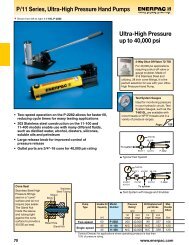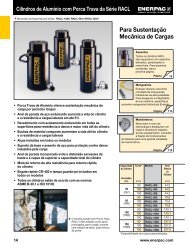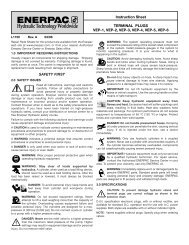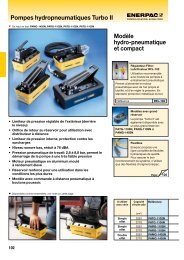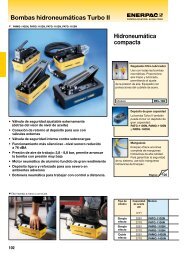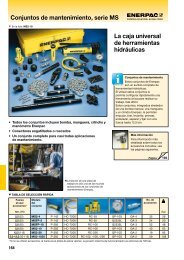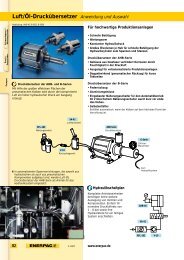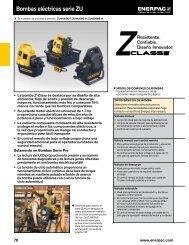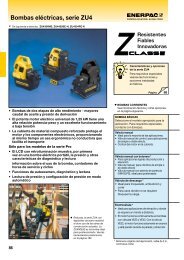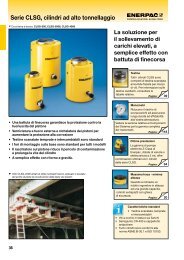Instruction Sheet ZU4 Classic Torque Wrench Pump - Enerpac
Instruction Sheet ZU4 Classic Torque Wrench Pump - Enerpac
Instruction Sheet ZU4 Classic Torque Wrench Pump - Enerpac
Create successful ePaper yourself
Turn your PDF publications into a flip-book with our unique Google optimized e-Paper software.
4. While holding the overlay behind the fl ange (see Fig. 8, View<br />
C) insert the fl ange onto the knob studs, repositioning the<br />
overlay as needed, and secure knobs fi nger tight (see Fig.<br />
8, View B). The fl ange will press the overlay onto the gauge<br />
and secure it in place. See torque wrench instructions for<br />
amount of pressure required to produce desired torque. Note<br />
that the maximum pressure varies for different wrenches and<br />
accessories.<br />
CAUTION: Refer to torque wrench instructions<br />
for wrench operating procedure.<br />
.<br />
View A View B<br />
View C View D<br />
Figure 8, Overlay Installation<br />
5.6 Pressure (<strong>Torque</strong>) Setting<br />
WARNING: Make these adjustments BEFORE<br />
putting torque wrench on nut or bolt head. The pump<br />
pressure setting may be above the pressure needed<br />
to provide the required torque for your application. Exceeding<br />
required torque will cause equipment damage and may lead to<br />
serious personal injury.<br />
Z-Class pumps are equipped with one user adjustable relief valve<br />
(see Figure 9). To limit the advance to the torque wrench it can be<br />
adjusted as follows:<br />
1. Loosen the relief valve locking nut and turn handle counterclockwise<br />
until there is a light drag when turning.<br />
2. Start the pump to allow the oil to warm.<br />
3. Press and hold the “ON/ADV” button to build pressure in the<br />
advance circuit. Turn relief valve control handle clockwise to<br />
increase pressure to desired value.<br />
Note: To get an accurate setting, decrease the pressure to<br />
a point below the fi nal setting and then slowly increase the<br />
pressure until it reaches the fi nal setting.<br />
4. Tighten the relief valve locking nut at the desired pressure<br />
value.<br />
5. Release the pendant “ON/ADV” button to allow the system<br />
pressure to return to the B-port by-pass setting. The motor<br />
will continue to run.<br />
6. Recheck the fi nal pressure setting by shifting the valve and<br />
pressurizing the system.<br />
5<br />
Control Handle<br />
6.0 MAINTENANCE<br />
Locking Nut<br />
Figure 9, Relief Valve Adjustment<br />
Frequently inspect all system components for leaks or damage.<br />
Repair or replace damaged components. Electrical components,<br />
for example, the power-cord, may only be repaired or replaced<br />
by a qualifi ed electrician, adhering to all applicable local and<br />
national codes.<br />
6.1 Check Oil Level<br />
Check the oil level of the pump prior to start-up, and add oil, if<br />
necessary, by removing the fi ll port plug. See fi gures 2 and 4.<br />
Always be sure torque wrench is fully retracted before adding oil<br />
to the reservoir.<br />
6.2 Change Oil and Clean Reservoir<br />
<strong>Enerpac</strong> HF oil is a crisp blue color. Frequently check oil condition<br />
for contamination by comparing pump oil to new <strong>Enerpac</strong> oil. As<br />
a general rule, completely drain and clean the reservoir every 250<br />
hours, or more frequently if used in dirty environments.<br />
Note: This procedure requires that you remove the pump from<br />
the reservoir. Work on a clean bench and dispose of used oil<br />
according to local codes.<br />
1. Remove the drain plug and drain all oil from the reservoir.<br />
Clean and reinstall the drain plug.<br />
2. Unscrew the 13 bolts holding the coverplate to the reservoir<br />
and lift the pump unit out of the reservoir. Be careful not to<br />
damage the fi lter screen.<br />
3. Thoroughly clean the reservoir and reservoir magnet (if<br />
equipped) with a suitable cleaning agent.<br />
4. Remove the pick-up fi lter screen for cleaning. (Do not pull<br />
on the screen or the bottom of the intake to avoid possible<br />
damage.) Clean the screen with solvent and a soft brush.<br />
Reinstall.<br />
5. Reassemble the pump and reservoir, installing a new<br />
reservoir gasket.<br />
6. Fill the reservoir with clean <strong>Enerpac</strong> hydraulic oil. The<br />
reservoir is full when oil level is as shown in Figure 4.



